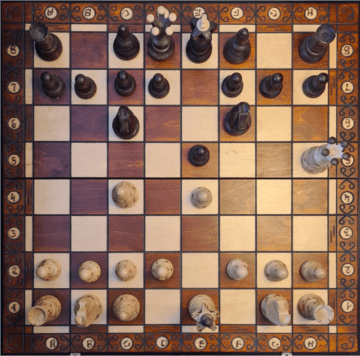by Jochen Szangolies

Even if you’ve never played chess in your life, the image in Fig. 1 is probably readily identifiable to you. The regular grid of the chessboard, white and black standing in opposition, perhaps even the individual pieces—knights, pawns, bishops, and so on—are a cultural staple.
If you have some familiarity with the rules of chess, however, you will see more than that: rather than a mere configuration of items, you’ll see moves—options, dangers, strategies. For instance, the white queen is threatened by the knight on f6: a knight always moves in a specific way, one step diagonally, one step straight, allowing it to move to the white queen’s spot to capture. To evade, the white queen could capture the black pawn on e5—but then, would be captured by the knight on c6. A much better option—the move this particular configuration of pieces seems to scream out to you, if you’re a chess player with some experience—is for the white queen to move to f7, capturing the pawn, for check and mate: the so-called ‘Scholar’s Mate’.
Familiarity with the rules of chess adds a semantic dimension to the chessboard. The pieces acquire a particular, individual character: the knight is that particular piece that moves one straight and one diagonal; the bishop is the piece that moves diagonally; and so on. Rules transform the chess pieces from inert physical objects to something with a particular identity, something almost agent-like, capable of acting towards a certain goal. However, removed from the chessboard, they loose this character: a bishop and a rook, connected at their bases, make for a passable model rocket ship, for example.
Indeed, in a pinch, you could easily take a chess pawn to replace one of the tokens in a game of Ludo, or Halma—there, despite its somewhat odd looks, it will nevertheless fit right in, given a new identity by a new set of rules.
The chess-, Ludo-, and Halma-boards are examples of rule spaces.
While we ordinarily think of rules as abstract entities, many have a concrete realization in the form of their domains of applicability—the rules of chess only apply on the chessboard, and in doing so, make that particular arrangement of black and white squares (which could equally well have hosted a game of checkers) into a chessboard. Moreover, by applying to objects (or agents) within that rule space, they are partly constitutive of those object’s identity: a knight is only a knight if it is subject to the rules governing the knight’s behavior, and thus, only on the chessboard.
Rule spaces, and the rules they embody, thus determine (at least in part) the essence of the objects contained within them: they are what gives them their individual character, what makes something that particular kind of thing. Removing an object from a rule space or inserting it into another are thus transformative actions: they change the object’s character.
Of course, rule spaces are not limited to the artificial, well-confined settings of board games. Indeed, we encounter them every day: different rules obtain within a public space than in your own home—the wearing of sweatpants is much more acceptable in the latter, for example. But this means that in the course of our day, we typically undergo many transformations: we can be a shopper, or a salesperson, or a traffic participant; we can adopt a public or a professional persona. By simply moving to a different space, we become subject to different rules, are expected to behave, and even think or feel differently, becoming, in a very real sense, different persons.
Liminality and Collisions between Rule Spaces
Rule spaces are not necessarily limited to physical space. They might have a temporal dimension, as well: working from home during the pandemic, you might have designated a certain part of your home to function as an office, at least on weekdays from nine to five. Indeed, some rule spaces have only a temporal dimension: different rules apply to the child than to the adult, for example, and applicability of these rules are (part of) what we mean by identifying a person as either. For instance, when we scold somebody for their ‘childishness’, we indicate that they have not behaved in accordance with the rules governing proper adult behavior.
But without a clear separation between rule spaces, this carries certain dangers: you might find rules from one space bleeding through into the other, as when you write a quick work email from the couch in the evening, or judiciously choose a webcam angle that lets you get away with sweatpants. Such collisions between rule spaces blur the boundary between different ways of being, different identities, and can lead to uncertainty and anxiety.
Therefore, transitions between rule spaces must be performed with some care. Often, they are governed by certain rituals: rites that, for instance, serve to govern the transition into adulthood. Starting out within one rule space, the ritual then delineates a series of steps to (safely) transition into the other, be it the recital of some sacred text, the performance of a certain feat, or a series of symbolic gestures. One enters the ritual a child, and emerges into the world of adults—that is, one transitions from one rule space into another.
But what about the in-between, that point where one might be, as the song goes, ‘not a girl, not yet a woman’? This is what ethnographer and folklorist Arnold van Gennep christened ‘the liminal’ early in the twentieth century in Rites de Passage. In the phrasing of Victor Turner, who took up and expanded upon the concept starting from the 1960s, a liminal state is anything ‘betwixt and between’ different states, places, or modes of being; for present purposes, it designates that mode of being that exists in the transition between distinct rule spaces.
This can be a simple, physical transition, such as stepping foot into a church, where different rules obtain than outside of it; or it can be a more complex rite of initiation, perhaps involving a protracted series of tests and evaluations. These transitions have an existential character, involving transitions between distinct ways of being; as such, they are typically events of high cultural significance. A liminal situation is one of rebirth, of unmaking a prior identity and forging a new one—but to do so, one must traverse a dangerous situation where one’s identity is ambiguous and unformed. Liminality exposes an existential void we encounter in the absence of identity-forging rules.
The concept of liminality challenges notions of strict, box-like categorization; it does not play well with the principle of the excluded middle, the either-or of Aristotelian logic. Liminality is all middle, all between, not a destination, but a transitory space.
There are certain real-world spaces that embody the experience of liminality, just as there are spaces that embody certain sets of rules. These are typically transitory spaces: airports, bus stations, hallways, hotel rooms. They are often characterized by the suspension of normal rules: one does not usually sleep in public, but sleeping people are a normal sight in airports. Often, liminal spaces are also in various states of ruin: a dilapidated, disused church has lost its status as a church, by virtue of the church-rules no longer applying, but it also hasn’t yet fully reverted to a state of nature—it is transitional in this sense.

An example of a liminal space is ‘the backrooms’ (see Fig. 2), the subject of a popular ‘creepypasta’ (an internet neologism deriving from ‘copy-and-paste’, i. e. ‘copypasta’). Its liminal quality is provided by its lack of furnishings—nobody lives or works there, it is nobody’s destination—combined with the strangely disused and run-down ambiance. It is also, to many people, profoundly unsettling.
Indeed, the liminal nearly always seems to possess an element of the uncanny. Connecting it to the notion of rule spaces, one begins to see why: there is safety in rules—there is no uncertainty about what you’re allowed to do in chess. The chess pawn may be a pawn, but in being so, it is certain of its identity; there is no room for self-doubt. But in a liminal setting, the rules have been suspended, and new rules not yet put into place: therefore, one’s identity is in flux, in doubt, and there are no general guidelines for behavior to follow.
In a sense, a liminal state is also one of freedom: you can choose your own identity. Hence, there is sometimes a strange attraction to liminal spaces, an odd sort of exhilaration in being freed from the confines of everyday expectations. This combination is not as strange as it might first seem: as Kierkegaard famously observed, ‘anxiety is the dizziness of freedom’. Dizziness, in this sense, is the sensation we have upon standing on the edge of a cliff: the realization of our own freedom to jump.
Thus, there is both promise and danger to liminality. Hence, most cultures strive to, if not regulate it (for that would just incur an infinite regress of rules and rules for the changing of rules, and so on), then at least to ritualize, and thus, reglement it. Typically, rites of initiation are presided over by those that have already passed through, and safely gotten to the other side, so to speak. Often, there is a master of ceremony, a shaman, or an elder who is tasked with ensuring the successful completion of the rite—a task which, however, may fail.
This opens up the possibility of failing to complete the transition between rule spaces, of getting stuck ‘betwixt and between’—of perpetual liminality.
Our Vampiric Present
Folklore brims with transitional creatures that are half-something, half-something else: chimeras, gargoyles, harpies and werewolves. Zombies and vampires, too: as creatures neither dead nor alive, but ‘undead’, they are stuck in the ultimate transition. Such beings stand outside of society, represent dangers attacking it from without, and those that meddle with them, do so at their own peril; similarly, the fate of those failing to complete a certain ritual is often that of being cast out—purging, in an act of cruel social hygiene, the liminal element from the community’s midst.

Rules are enforced by what the existentialists called ‘le regard’, the gaze of the other—our opponent would protest our making an illegal move in chess; parents chastise their children for behaving inappropriately in church; and so forth. Those in a liminal state are thus, to a certain extent, an offense to the gaze of others: hence, they must be hidden from sight.
Liminality then carries the internal danger of losing one’s own identity, and the external danger of ostracism—with which come twin freedoms: choosing one’s essence, and casting off the shackles of other’s expectations. ‘Essence’, here, is meant in the sense in which ‘existence precedes essence’: while a crafted object has something it is for—such as a pair of scissors being for cutting—a human being is ‘thrown’ into the world without such express purpose, and thus, is condemned to craft their own. Rule spaces are a way to structure the world such that the work of essence-crafting is partially offloaded into our surroundings: just like the knight on the chessboard, we know who we are under the aegis of a particular set of rules. Thus, we relinquish a bit of our freedom to gain existential safety.
The attraction of liminality is then the desire to win back that freedom. The vampire, at least in its modern, sexy form, might be taken as the archetype of successfully embracing the freedom of liminality—cast out from society, forced to remain in darkness, yes; but also, no longer bound to the rules of ordinary mortals, freed from death itself. The zombie, on the other hand, is the failure of negotiating liminality, leading to the total loss of self.
Rule-Spaces, and with them, the notion of liminality, do not merely exist on the level of individuals. Social groups, from families, to clubs, to entire nations themselves are subject to certain rules; and in times of upheaval—war, revolution, or other forms of social change—these are suspended, leading to liminal experience on the scale of entire societies. The past year has been a state of enduring liminality for much of the globe, with the COVID-19 pandemic profoundly reshaping the rules of society—and with, as yet, no clear concept of which new rules expect us on the other side.
Indeed, while transitions on the individual level are typically presided over by those already familiar with the transition, for a society undergoing an unprecedented evolution, no such ‘masters of ceremony’ exist—yet, there may be those trying to fill the ensuing void: fake shamans, prophets and leaders using the prevalent anxiety and confusion for their own gain.
In Reflexive Historical Sociology, the Hungarian sociologist Árpád Szakolczai has argued that, in fact, modernity is a state of ‘permanent liminality’: social change has itself become the norm. This can be thought of as an antithesis to the oft-invoked ‘End of History’: a steady state is never reached; rather, a transitory state is perpetuated.
There is an added wrinkle to consider, here. If there is such a thing as permanent liminality, then this corresponds to a transition that is never completed—we never emerge out into a ‘new normal’, a rule-space ‘across the border’. Indeed, there may be no ‘beyond’, nowhere to cross into.
There are two examples of such a ‘boundary without an outside’ in individual human existence. One is death, at least to the atheist: death is something that can be approached, but not crossed over into, as it entails the dissolution of that which does the crossing. Death, and the act of dying, is not liminal, but asymptotic: we can approach, but never reach it.
The other such asymptote is an inner one: the self, being that which experiences, is never experienced itself. Whenever we look inside for the self, we find that the self is what’s doing the looking, so to speak, but is never the object of its looking. It’s like trying to turn around fast enough to catch a glimpse of our own faces (or eyes, perhaps). The subject can never transition into objecthood; any attempt to transcend the rule-space that imbues it with its essential subjectivity must lead to its unmaking.

We can never experience death, and never experience the self, as such. Human existence is thus bracketed between two asymptotes, beyond which threatens a vast nothingness (at least, as far as our experience and capacity for conceptualization is concerned). Perhaps vampires is a bit strong, but we are inherently liminal creatures—as Nietzsche put it, the rope tied over an abyss between beast and overman. We must come to terms with our liminality, and that of our age; we cannot rely on god-given rule-spaces to organize our being. This involves the difficult work of steadily carving out our own identity, in the absence of external forces shaping it for us, designing us for a purpose like a pair of scissors, binding us to rules like the knight on the chessboard; but the alternative is the loss of self and lapse into zombie-hood.
